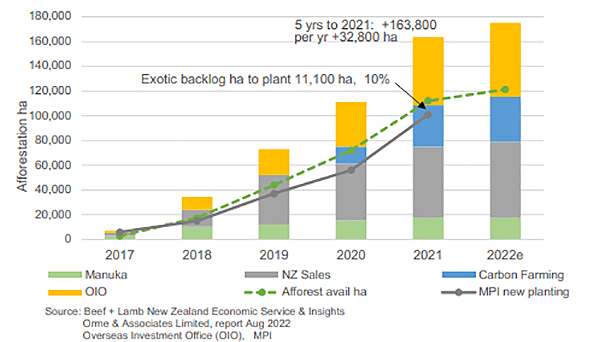
On Wednesday this past week, the Minister of Agriculture Damien O’Connor had a comprehensive conversation on National Radio with Kathryn Ryan (9 to Noon).
Kathryn Ryan has often proved to be quite a rational cheerleader for farmers and over time has had a number of ‘guests’ who have provided additional insights in the issues around ag and particularly around farm emissions.
In this case, in my view, she drew out some weaknesses in the Ministers understanding around ‘trees on farms’.
The interview focused largely around the issue of land use change to non-productive forestry but also touched on the issues farmers have with the changes to the proposed He Waka Eke Noa (HWEN) policy. To me the non-productive forestry (NPF) issue is a greater threat to farmland than the sequestration-or-not questions under HWEN (some may disagree) and it was in this area that the Minister appeared to show his ignorance.
The important area of how much land was being sold/converted to NPF was asked and he didn’t know and seemed unconcerned.
Beef+LambNZ in an earlier report estimated that two-thirds of 92,000 ha of land being converted to forestry between 2017-2020 was NPF. However, Ryan said anecdotal reports were that there are potentially 100,000s of ha being brought up with the aim of being converted. The Minister promised to get back to her with numbers as he didn’t have them on hand. To be fair, given time lags between land sales and planting is going to also provide some inaccuracies however a trend line should provide some clarity on what the direction is.
At this point, to my knowledge, there have been no new numbers provided from him. The sale of Huiarua and Matanui Stations (adjoining each other and making up about 6,000 ha) was raised. The Minister said government was very reluctant to interfere in the area of private property, but he seemed oblivious to the fact that the environment in which forestry planting is thriving has been directly created by his government.
He did point out that the Huiarua and Matanui stations were supposed to be converted to production forestry, and that despite being around two and a half hours from the nearest port (Gisborne), planting was economic due to the time being saved in planting and silviculture. This obviously is attributable to the quality of the farmland as Huiarua Station is a past winner of the Gisborne Farm of the Year (I had the pleasure to attend their field day).
If farmland of this scale and quality and distance from port is considered economic to buy and convert then obviously any land currently suitable for sheep and beef farming would have to be considered.
No doubt this is why the land area being bought up by ‘foreigners’ is attributed to have doubled in the last twelve months. A report out Friday provides more concerning numbers around land conversions.
“Overall, from 2017 the whole-farm purchase (for forestry conversion) area totalled 175,000 ha. Of this, the grassland area for afforestation was 134,500 ha, 77 percent of the total purchased area”.
According to the report only 21% of this land has erosion or is erosion prone. In addition to the significant planting in the East Coast regions, Waikato/South Auckland, Otago, and Southland have now joined the regions being converted.
In graph form the trends (which the Minister didn’t have) are below:

The graph shows the cumulative trend for farmland purchased for forestry in the bar charts. The dotted graph line shows the cumulative grassland area available for exotic afforestation from the Orme report. The solid graph line shows the cumulative area planted based on Te Uru Rākau’s survey of exotic tree seedlings sold for new area planting. The gap between the two graph lines identifies the land area backlog to be planted.
The increase in the number of seedlings sold should have been an early warning to the Minister of the increase in the land area being planted.
A table also included in the report shows the economics of plantation conversions. This table was calculated with an ETS price of $70. Currently it is around $80 and predicted to increase significantly.

The scale of this land conversion issue is where I see the biggest threat to hill country farming coming from, not from what is included in paid sequestration for farmers.
For example, in advice from the Climate Change Commission to Government, a dairy farm with riparian planting consisting of a mix of native grasses, shrubs and trees along 3.2 km of stream with a total area of planting of 4.5ha is estimated to sequester between 0.45 and 13.5 tCO2e per year. At a carbon price of $25/tCO2e, this has a value between $10 and $340 per year. Note the carbon price assumption, but still relatively small change when compared to carbon farming.
In addition is the added cost of assessing this.
This other issue I wonder about is; if the proposed HWEN areas of sequestration desired by farmers falls outside of the internationally recognised areas (which I believe it does. But happy to be proved wrong) then who pays? The taxpayers are already subsidising farming with the amount still to be decided for the future but currently 100% and if they have to then front up for a payment not covered by internationally recognised norms, I’m sure they won’t be happy.
He Waka Eke Noa programme director Kelly Forster wrote a piece which also provides some light on HWEN policy remembering that it is still under the “consultation” stage. In the meantime, perhaps the Minister for Ag should relieve Stuart Nash of his Forestry portfolio as he (O’Connor) appears to be doing more than anyone through a lack of advocating for farming.
6 Comments
Since coming to office in 2017 this Labour government have taken an adversarial approach to the farming industry ... we've witnessed a stream of hair brained ideas thrust upon our nations most important export earnings sector ...
... Damian O'Conner has happily toed the party line ... he's not been there to help them , or to listen : his role has been to order & dictate ...
But remind me , who swung in behind Labour during the 2020 election , as a strategy to keep the Greens out ... the farmers ... reaping what you showed , guys ...
Where did the $ 25 per tonne of carbon figure come from?.
I'll have to listen to the interview, but politicians are generally reluctant to quote numbers. I find it a bit hard to infer that that means he is not aware that a lot of farmland is been converted, or is unconcerned about it.
If more land is being planted in trees why are individual farmers being required to reduce emissions at the per farm level?
Methane and carbon been treated seperatley. If you mean less farmland means less methane emissions, that is a good point. But I think despite the hype, it is still mainly low head per ha farmland that is been converted.
The government's own official advice suggests a twenty percent reduction in the sheep and beef sector alone.
This comment should be of major concern to New Zealand. That is a huge impact on food production and this government is not concerned...
The sad reality is 20 to 40% of hill country farmers are losing money every year already.

We welcome your comments below. If you are not already registered, please register to comment.
Remember we welcome robust, respectful and insightful debate. We don't welcome abusive or defamatory comments and will de-register those repeatedly making such comments. Our current comment policy is here.